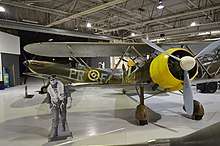Royal Air Force Museum London
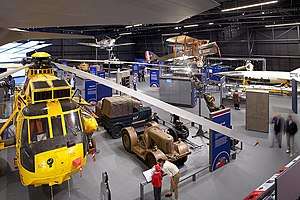 | |
| Established | 15 November 1972 |
|---|---|
| Location |
Colindale London, NW9 United Kingdom |
| Type | Aviation museum |
| Visitors | 345,151 (2017)[1] |
| Public transit access |
|
| Website |
www |
The Royal Air Force Museum London, commonly called the RAF Museum, is located on the former Hendon Aerodrome, with five major buildings and hangars dedicated to the history of aviation and the Royal Air Force. It is part of the Royal Air Force Museum, a non-departmental public body sponsored by the Ministry of Defence and a registered charity.[2]
A second collection of exhibits, plus aircraft restoration facilities, is housed at the Royal Air Force Museum Cosford at RAF Cosford in Shropshire, five miles northwest of Wolverhampton.
History
The Museum site at Colindale was once part of the RAF Hendon station and prior to that, one of very first civilian airfields, acquired by Claude Grahame-Whight in 1911.
In 1914, the thriving aerodrome was requisitioned for Home Defence during the First World War. Hendon became a Royal Naval Air Station, training new pilots in the flying schools on site. Operations ceased after the end of the Great War. Nevertheless, the aerodrome remained a focal point for aviation as the Royal Air Force staged their spectacular annual air displays at Hendon between 1921 and 1937. These aerial pageants brought the RAF to the public, showcasing the latest aircraft as well as spectacular aerobatics by the RAF pilots. At its peak, in 1937, the annual display attracted over 200,000 spectators.
From 1927 to 1939 Hendon was the home of No. 601 Squadron, nicknamed the 'Millionaires Squadron' due to the wealth and upper social class of its volunteers. In 1939, the outbreak of war saw Hendon once again become an operational RAF station, home to No. 24 Transport and Communications Squadron. RAF Hendon also served briefly as a fighter station during the Battle of Britain.
The last flight to Hendon by a fixed-wing aircraft took place on 19 June 1968, when the last operational Blackburn Beverley was delivered to the Museum prior to its royal opening in 1972. Soon afterwards, the runways were removed to make way for the Grahame Park Housing Estate. The official closure of RAF Hendon took place on 1 April 1987.
The museum was officially opened at the Colindale (then part of Hendon) London site on 15 November 1972 by Queen Elizabeth II. The hangars housed 36 aircraft at opening. Over the years, the collection increased, and aircraft not on display at Hendon were stored or displayed at smaller local RAF station museums.
In 2005, a Consolidated B-24 Liberator was moved from Cosford to Hendon. It was presented to the museum by the Indian Air Force, which used this World War II bomber until 1968. In exchange, a Vickers Valiant was sent to Cosford to become part of the new Cold War exhibition. In 2009 the museum took delivery of a FE2b World War I bomber, which had been in production for the museum for over 18 years and is one of the few examples of this aircraft in the world.
The first director of the museum was Dr John Tanner, who retired in 1987. In 1988, Dr Michael A. Fopp (who had previously directed the London Transport Museum) was appointed director general of all three sites operated by the museum. Retired Air Vice-Marshal Peter Dye replaced Fopp as director general on 9 June 2010.[3] In October 2014, it was announced that Maggie Appleton was to be appointed as CEO of the museum.[4] Ms Appleton took up the new role in January 2015, a departure from the traditional role of director general which was held by Peter Dye until his retirement in late 2014.
The Battle of Britain Museum (later Hall) was opened by Queen Elizabeth the Queen Mother in November 1978, the event attended by many former fighter pilots. On 3 October 2016 the Battle of Britain Hall was permanently closed after being in existence for some 38 years. The collection was dispersed to allow the Battle of Britain to be presented across both the London and Cosford sites as part of other themed exhibitions within the RAF Centenary's celebrations.
The Hendon site has been extensively revamped with financial assistance from the Heritage Lottery Fund and other donors to mark the RAF Centenary in 2018. Changes include: new exhibitions and commercial facilities in the hangar that previously hosted the Battle of Britain Collection, a new restaurant facility (in Building 52), a new car park adjacent to Grahame Park Way, relocation of the fibreglass Hurricane and Spitfire gate guardians to the main gate, a new exhibition in what was the 'Milestones of Flight' hangar, and landscaping of the old car park to create a grassed recreational area at the centre of the site. The landscaping work is intended to evoke in the visitor a sense of the former Hendon airfield in what has become a heavily urbanised area. To facilitate the exhibition changes, a number of aircraft exhibits have been relocated on site whilst others been transferred to or from Cosford.
Description
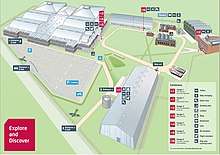
The Royal Air Force Museum’s purpose is to tell the story of the RAF through its people and collections. It is a National Museum, a Government non-departmental public body (NDPB) and a registered charity. The Museum works closely with the RAF, its sponsor organisation at the Ministry of Defence. It has two sites open to the public at Colindale, North West London, and Cosford, in the West Midlands.
The Royal Air Force Museum London comprises several exhibitions spread over 6 hangars:
- Hangar 1 with two new exhibitions, RAF Stories and RAF First to the Future:
RAF Stories, The First 100 years 1918-2018 of the RAF. This exhibition tells the story of the RAF’s first 100 years, from its creation in 1918 as the world's first independent air force. It explores the different roles of the people of the RAF, alongside the amazing revolutions in technology. Showcasing engaging displays it broadens the traditional view of the RAF toward that of a diverse and constantly evolving organisation.
RAF – First to the Future invites visitors to explore the work of today's RAF and how the service is preparing for the future.
- Hangar 2 (the Grahame-White Factory):
First World War in the Air exhibition: The story unfolds from the earliest days of flight here on the site of The London Aerodrome, through four years of World War to the formation of the independent Royal Air Force in 1918. This exhibition was awarded 'Best Heritage Project', voted by the public, in the 2015 National Lottery Awards.[5]
- Hangar 3 and 4: Historic Hangars
These hangars focus on the aircraft of the Second World War and the Cold War. Centrally placed are four original Battle of Britain fighter aircraft, the Hawker Hurricane, the Messerschmitt Bf 109, the Supermarine Spitfire and the lesser known Fiat CR.42. It also holds the Wings over Water exhibition, an extensive helicopter collection and an impressive number of Cold War jet aircraft. These hangars have recently been refurbished with life-size silhouettes of different RAF aircrew who are, in their own way, connected to a specific aircraft in the collection.
- Hangar 5: The Bomber Hall
Battle of Britain: the iconic Junkers Ju 87 Stuka, Heinkel He 111 and Bristol Blenheim show the bomber element during the Battle of Britain.
On target: Bomber Command, from the vulnerable Fairey Battle to the famous Avro Lancaster and the mighty Avro Vulcan.
Friendly Invasion: explains how the American Eighth Air Force operated from Britain to attack targets over Nazi Germany.
- Hangar 6: Age of Uncertainty
The RAF in an Age of Uncertainty explores the story of the RAF from 1980 to today. Visitors will be able to find out more about the RAF’s different roles in the Falklands Conflict, Operation Desert Storm in Iraq, the liberation of Kuwait, and recent operations in the Balkans, Afghanistan and Libya.
This Hangar is also the home for a modern STEM centre, incorporating several classrooms, reaching a far wider range of schools than previously possible, and using a cross-circular approach to include STEM as well as history.
As of 2010, it had close to 100 aircraft, including the Avro Lancaster S-Sugar, which flew 137 sorties. It also includes the only complete Hawker Typhoon. Recently added are a Westland Sea King helicopter, flown by HRH Prince William, a Gnat fast jet trainer of the Red Arrows, and a full-scale mock-up of the F-35 Lightning II stealth fighter.
The different hangars are connected through a roundabout, which circles around an open grass area, perfect for picnics, and a green meadow landscape. The main entrance point is Hangar 1, which is accessible through a pedestrian gateway. The Museum also features a new restaurant, which has been built within a 1930s mess store building. Next to it is a fun yet safe children's play area with mini RAF aircraft, vehicles and buildings. A volunteer centre has been created within Building 69, originally a parachute packing RAF building.
The Museum's archives, containing many thousands of paper documents, books and photographs are situated on the top floor of Hangars 3/4/5. Access to the archives is possible by making an appointment to visit the Reading Room.[6]
There is a large car park at the site, including charge points for electrical vehicles. There are reasonable public transport links, with Colindale tube station on the Northern Line, about 600 m away.
A recent project is the RAF Stories online app, which connects with visitors and audiences. This project will collect and share 'digital scrapbooks' created and curated by anyone who has a RAF story to share - whether their own, of family members or partner organisations.
A changing selection of these stories will be available for visitors to explore in the new exhibitions, as well as offering the opportunity to add their own story to the archive.
Aircraft on display
Hangar 1
Main point of entry to the Museum with shop, café and corporate areas. The café provides seating under the wings of the Sunderland flying boat.
Two new exhibitions: RAF Stories: the first 100 years of the Royal Air Force
RAF: First to the Future
- Lockheed Martin F-35 Lightning II (display mockup)
Hangar 2 (The Grahame-White Factory)
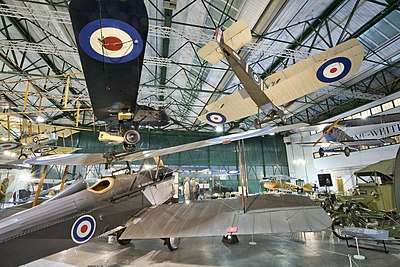
Hangar 3 and 4 (Historic Hangars)
Hangar 5 (The Bomber Hall)
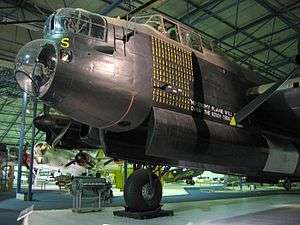

- Airspeed Oxford I
- Avro Anson I
- Avro Lancaster B.I
- Avro Vulcan B.2
- Boeing B-17G Flying Fortress
- Bristol Blenheim IV
- Consolidated B-24L Liberator
- de Havilland Mosquito B.35
- Fairey Battle
- Focke Wulf Fw 190A-8/U-1
- Handley Page Halifax II (recovered wreck)
- Heinkel He 162A-2
- Messerschmitt Bf 110G-2
- North American TB-25J Mitchell
- North American P-51D Mustang
- Percival Prentice
- Heinkel He 111H-20
- Junkers Ju 87G-2
Hangar 6 (Age of Uncertainty)
- BAe Harrier GR.3
- Boeing Chinook front section
- Eurofighter Typhoon (prototype)
- Sepecat Jaguar
- Hawker Siddeley Buccaneer S.2B
- Lockheed C-130 Hercules cockpit section
- Panavia Tornado GR.1A
Aircraft which have been moved to other locations

- Boulton Paul Defiant now in Cosford.
- Gloster Gladiator I now in Cosford
- Junkers Ju 88R-1 now in Cosford.
- Messerschmitt Me 262A-2a Schwalbe now in Cosford
- Gloster F.9/40 (now in Cosford)
- Supermarine Seagull V now in storage.
- V-1 Flying Bomb not on display.
- V-2 Rocket not on display.
- Westland Lysander III now in Cosford
- Bristol M.1c now in Cosford
- Sopwith 1½ Strutter now in Cosford
- Sopwith Pup now in Cosford
- Vickers Vimy now in storage
Engines on display
See also
References
- ↑ "ALVA - Association of Leading Visitor Attractions". www.alva.org.uk. Retrieved 25 April 2018.
- ↑ Charity Commission. Royal Air Force Museum, registered charity no. 244708.
- ↑ http://www.times-series.co.uk/news/8161994.New_director_general_announced_at_RAF_museum/
- ↑ http://www.museumsassociation.org/museums-journal/news/27102014-luton-culture-chief-moves-to-head-royal-air-force-museum
- ↑ https://advisor.museumsandheritage.com/news/royal-air-force-museums-first-world-war-in-the-air-exhibition-wins-national-lottery-award/
- ↑ https://www.rafmuseum.org.uk/research/visit-our-reading-room.aspx
External links
| Wikimedia Commons has media related to RAF Museum London. |
